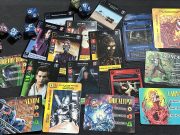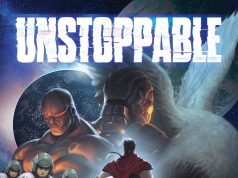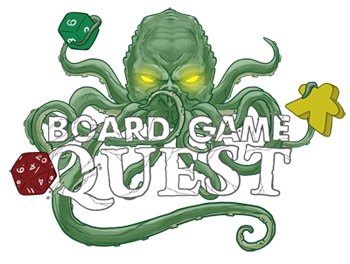This is a guest post from Andrea Champagne.
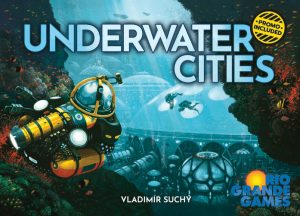 Underwater Cities was an early purchase when I was still in the “must-buy-it-if-it-can-be-played-solo” thought process. Thinking solo-able games were a limited market (WRONG!), I bought this without knowing much about it. I have never regretted this purchase. Underwater Cities has become one of my most-played games.
Underwater Cities was an early purchase when I was still in the “must-buy-it-if-it-can-be-played-solo” thought process. Thinking solo-able games were a limited market (WRONG!), I bought this without knowing much about it. I have never regretted this purchase. Underwater Cities has become one of my most-played games.
I like thematic ambient sounds in the background when I play. ‘Sunken Treasure’ from Tabletop Audio is my go-to for Underwater Cities. So queue it up for yourself and let’s dive in. (Sorry – couldn’t resist, only water pun. Promise).
Gameplay Overview:
Your goal is to build a network of cities and support structures to create a livable underwater habitat. Underwater Cities is primarily uses an engine builder/resource and hand management mechanic. The game is played over three Eras. There are four rounds in the first Era and three rounds in Eras 2 and 3. Each round is three turns. Each Era has its own deck of cards. Each turn, you place one of your markers on a colored space on the board. You take the space action and play a card from your hand. If the card is the same color as the space you’ve played, you play the action from the card as well. Actions can be played in any order (card first, then space, or space first, then card).
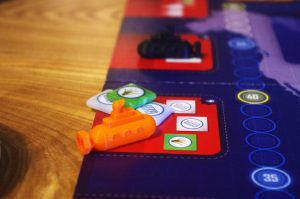
Actions allow you to build cities, farms, laboratories, desalination plants, or tunnels on your individual player board. Some cards are played immediately, others go into your play area to be played as a later action, some are held for game bonuses later, and some have repeating actions or bonuses.
After each Era is a production phase. During production, cities and structures generate credits ($$) and/or resources. You must feed your cities at the end of the production phase. Then you switch decks to the new Era and start again.
In multiplayer games, the highest score wins. There are no rule changes for solo play, and only one feature of the multiplayer game (government contracts) is not used in solo.
In the box, solo mode has win conditions: 7 cities and 100 points. Solo mode plays an automa which occupies one space on the board per turn and advances at the beginning of each round. The automa does not collect resources or points. The automa moves in a predictable pattern which can be both good and bad.
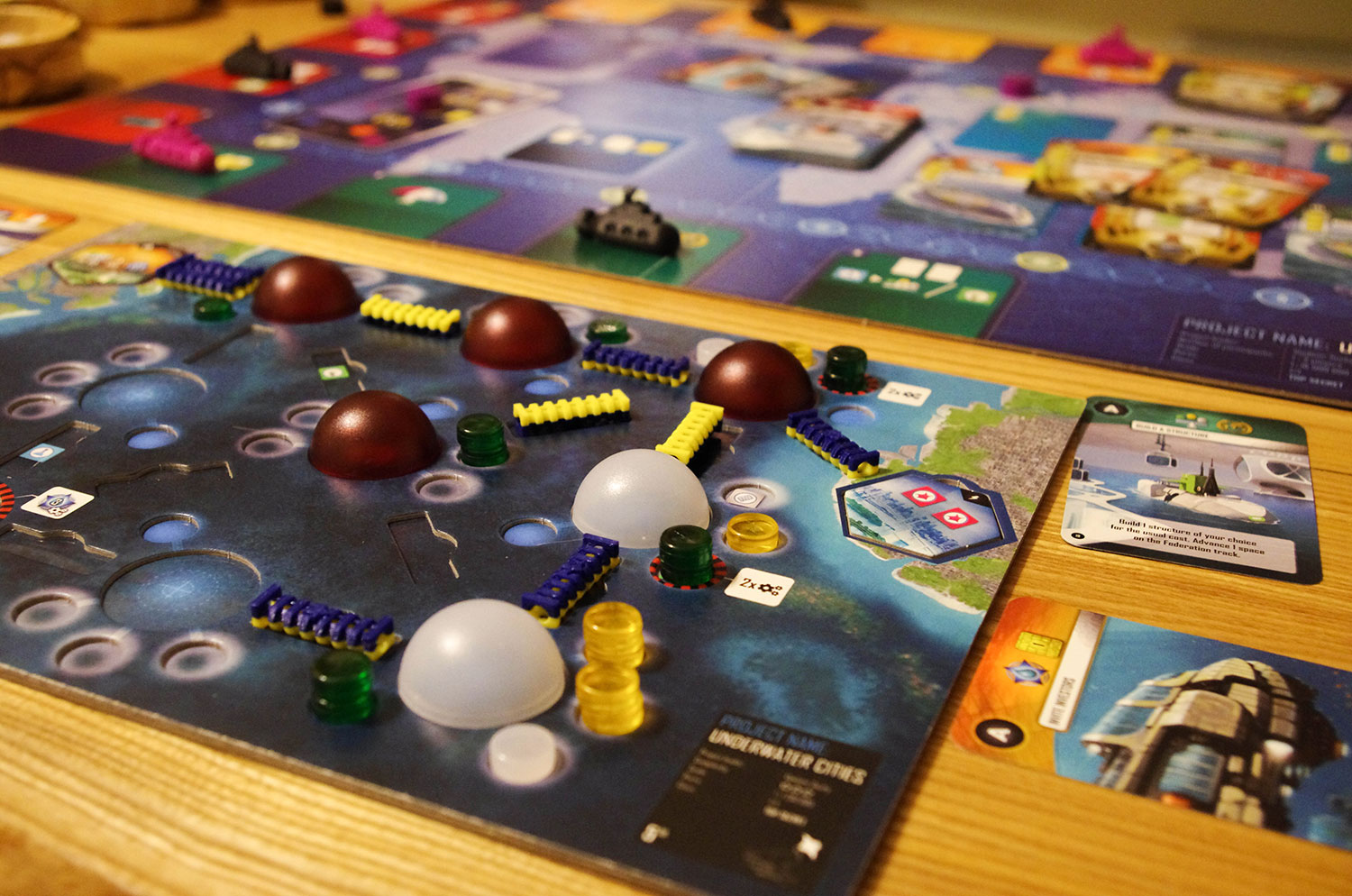
Game Experience:
Note: This experience is based on solo play only.
I really enjoy this game. The combination of board action and card action creates a ton of possibilities. The limited hand size keeps decision-making from becoming overwhelming. The tightness of resources means you need to plan each action carefully, and it’s best to think ahead at least one or two turns. Since you replace every card as you play it, you also have to be able (and willing) to change plans as needed.
Each game is thirty turns (ten rounds of three turns each) ad there is a lot that has to happen in those turns. The turn limit creates tension, and while there is no actual ticking clock, it does have a bit of that feel. You can’t delay big actions; they have to be taken when possible. Resources are tight and stay tight through the game.
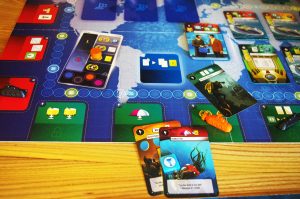
There are two production phases during gameplay, which generate a lot of resources at once. I often come out of production feeling pretty flush, only to find myself lacking critical resources two turns later. Resources can be gained during the round, but usually just a few. Letting you choose to perform either card or space action first means you can gain the resources needed to perform an action in the same turn you perform the action. It is a great feeling when that happens. It’s really satisfying to activate a card in the play area to provide resources or another action, so you have a big turn. Conversely, sometimes you just don’t have the cards you need, so you perform a board action and just discard a card in the wrong color (there is no action from the card if the colors don’t match). Actions are precious; losing them hurts.
This game has a lot of tough choices, but the restricted board spots and three-card hand limit keep it moving. Actual game-play time for me is usually one hour.
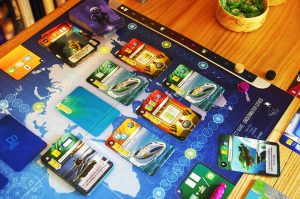
The actions and terminology are thematic. The artwork has a futuristic look with colors that remind me of animated movies. This game would be tough if you are color blind, as there are no icons for the colors (red, green, and yellow). The text can be smallish too. I bought this second-hand with upgraded pieces and double-layer player boards. The standard game without upgrades has single-layer boards, and this is a real shame. Your cities are small domes, and the support buildings are plastic disks. A careless reach or floppy sleeve can make a mess even with double-layer boards. If you have pets who like to ‘help’ you play a swishing tail can wipe out a couple rounds worth of work.
There are about ten different types of tokens. Setting up from opening the box to play time takes approximately 15 minutes when you know where you want everything and have your token containers ready. Re-setting between games isn’t bad, return the parts from your city and shuffle the decks, less than 15 minutes.
Final Thoughts:
The solo win conditions are hard to achieve. Seven cities are a lot with limited resources. Points build slowly during the game, although there are big gains during the final scoring. I have played this game over 30 times. I have never won. But I am always convinced that I can do better next time, so I reset it and start again. I think that’s why I love Underwater Cities. It makes me want to keep playing, keep trying new strategies. I keep looking for some clever play I didn’t get to make last time.
Final Score: 4 Stars – Great Game, solidly integrated mechanics with a lot of choices and just the right amount of luck.
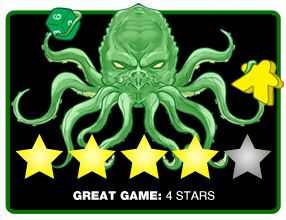 Hits:
Hits:
• Variety of action combinations for replayability
• Tight game play
• Theme is integrated without overwhelming
Misses:
• One more round. Please!
• Automa gets predictable
• Really needs double-layer player boards
 About the Author: A relative newcomer to the hobby, Andrea is a solo gamer still exploring the many, many boardgaming options while looking for anything she doesn’t like. So far, the only thing she refuses to try her hand at is 18XX.
About the Author: A relative newcomer to the hobby, Andrea is a solo gamer still exploring the many, many boardgaming options while looking for anything she doesn’t like. So far, the only thing she refuses to try her hand at is 18XX.






